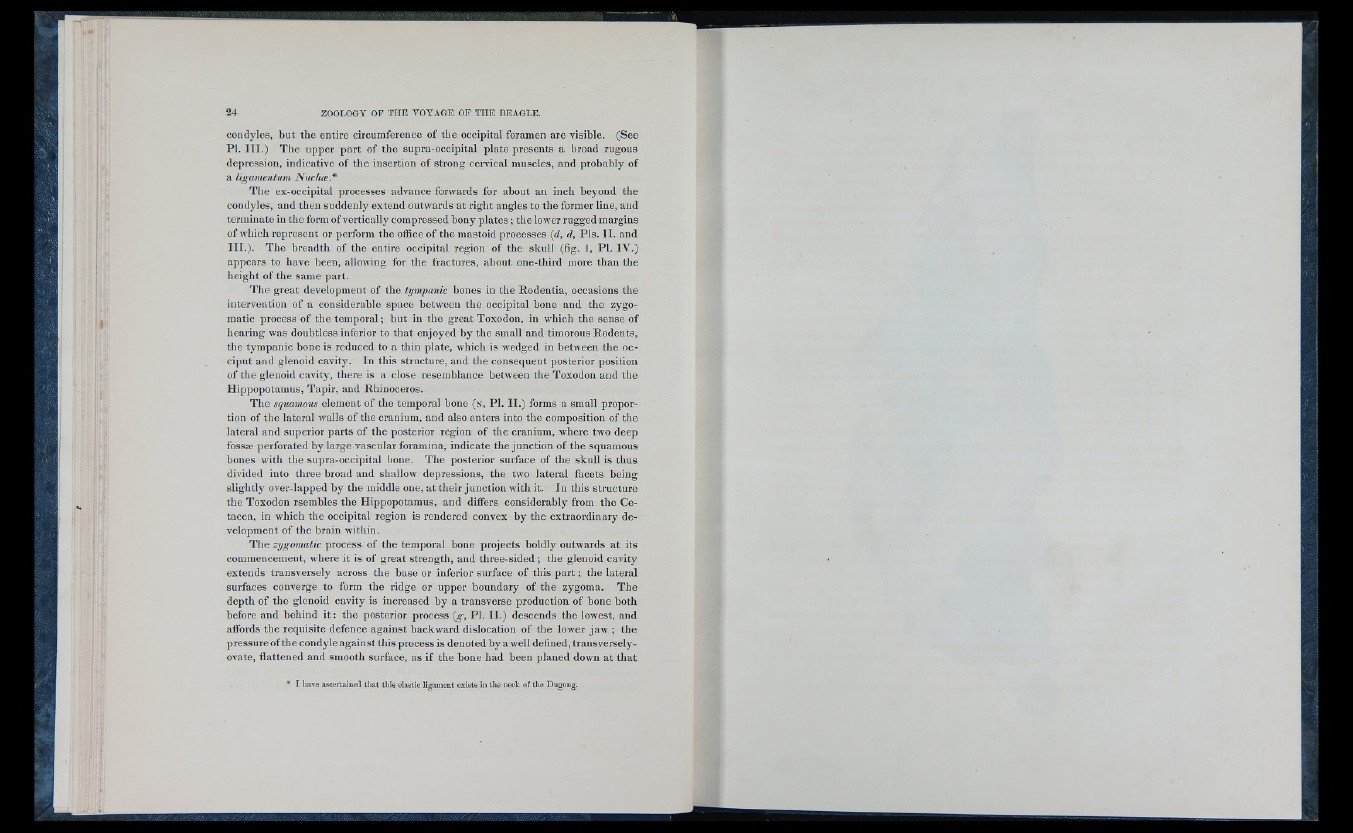
condyles, but the entire circumference o f the occipital foramen are visible. (See
PI. I I I .) The upper part o f the supra-occipital plate presents a broad rugous
depression, indicative o f the insertion o f strong cervical muscles, and probably o f
a Ugamentum Nuch<e*
The ex-occipital processes advance forwards for about an inch beyond the
condyles, and then suddenly extend outwards at right angles to the former line, and
terminate in the form o f vertically compressed bony p la te s ; the lower rugged margins
o f which represent or perform the office o f the mastoid processes (d, d, P is. II. and
I I I .) . The breadth o f the entire occipital region o f the skull (fig. 1, PI. IV .)
appears to have been, allowing for the fractures, about one-third more than the
heigh t o f the same part.
The great development o f the tympanic bones in the Rodentia, occasions the
intervention o f a considerable space between the occipital bone and the zygomatic
process o f the temporal; but in the great Toxodon, in which the sen se of
hearing was doubtless inferior to that enjoyed by the small and timorous R odents,
the tympanic bone is reduced to a thin plate, which is wedged in between the o c ciput
and glenoid cavity. In this structure, and the consequent posterior position
o f the glenoid cavity, there is a close resemblance between the Toxodon and the
Hippopotamus, Tapir, and Rhinoceros.
The squamous element o f the temporal bone ( n , PI. I I .) forms a small proportion
o f the lateral walls o f the cranium, and also enters into the composition o f the
lateral and superior parts o f the posterior region o f the cranium, where two deep
fossee perforated by large vascular foramina, indicate the junction o f the squamous
bones with the supra-occipital bone. Th e posterior surface o f the skull is thus
divided into three broad and shallow depressions, the two lateral facets being
s ligh tly over-lapped by the middle one, at their junction w ith it. In this structure
the Toxodon rsembles the Hippopotamus, and differs considerably from the Cetacea,
in which the occipital region is rendered convex by the extraordinary development
o f the brain within.
The zygomatic process o f the temporal bone projects boldly outwards at its
commencement, where it is o f great strength, and three-sided; the glenoid cavity
extends transversely across the base or inferior surface o f this p a r t; the lateral
surfaces converge to form the ridge or upper boundary of the zygoma. The
depth o f the glenoid cavity is increased by a transverse production o f bone both
before and behind it : the posterior process {g , PI. I I .) descends the lowest, and
affords the requisite defence against backward dislocation o f the lower jaw ; the
pressure o f the condyle against this process is denoted b y a well defined, transversely-
ovate, flattened and smooth surface, as i f the bone had been planed down at that
* I have ascertained th at this elastic ligament exists in tlie neck of the Dugong.